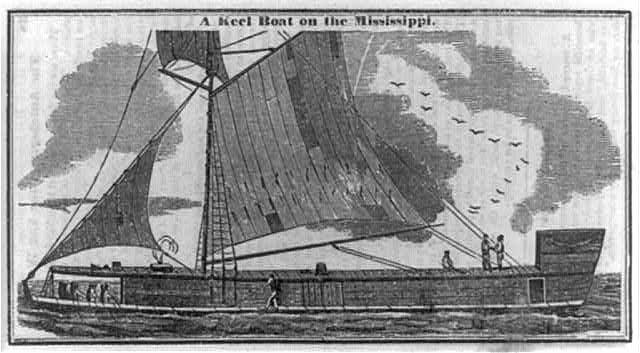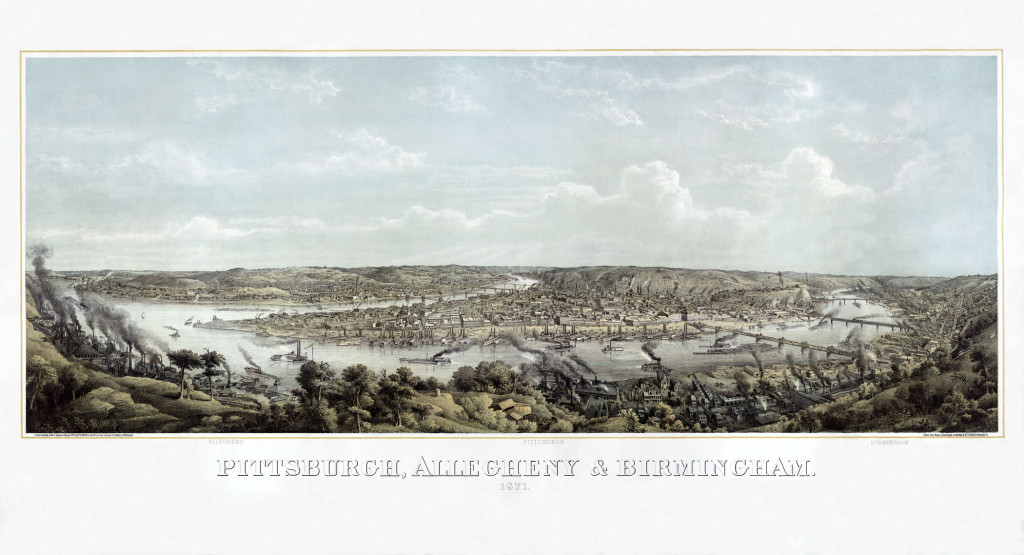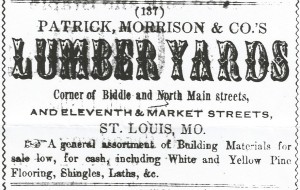Note: I am descended from William (1) Patrick and will be following that line the most. I will include information about James Knox (2) Patrick and his descendents when I find something interesting (and there is), but that branch is not my main interest. William and James spent most of their adult business lives intertwined in various lumber and shipping interests and I will follow that in this narrative. For information about their other interests and life events, you will find that on their individual pages (when I publish them). (See explanation of numbers.)
1800
James (1) and Nancy Knox Patrick, Scotch Presbyterians, came to the United States about 1800 from County Antrim in Ireland. They settled in Birmingham, PA, then a little hamlet across the Monongahela River from Pittsburgh.
They had five children, only four of whom reached adulthood. Their first son, Hugh, died before he was a year old. James Knox (2) was born July 17, 1808. Jane was born October 28, 1810. William (1) was born February 14, 1814, and Mary Ann was born June 27, 1816.
James (1) was a master stone mason. He worked on many government and military projects in the growing city of Pittsburgh. Around 1826, he worked on the Western Penitentiary and got into business difficulties resulting in losing all his money in 1828. James Knox (2) was already in business building furnaces for local glass works and the incipient steel industry. William (1) had to quit school. His first job, or at least an early job, was as a cabin boy on a river boat. One day, he was told to cook a pot of beans for the crew. He filled a pot with beans and water to soak. The result was a galley full of beans! Eventually, William started working in the office of one of the glass works in Birmingham, where he learned about business.
Family lore has it that William met and became friends with Abraham Lincoln while both were working on the river. Lincoln took two flatboat journeys to New Orleans, one in 1828 and one in 1831. It is possible that they met.
James(1) died December 13, 1832 and Nancy passed away nine years later on December 18, 1841. Both of them were buried in Birmingham or Pittsburgh. In 1863, the cemetery was dismantled and their son, James Knox (2), had them moved to the family plot in the Bellefontaine Cemetery in St. Louis. (Plots are still available for any family member who wishes be buried in St. Louis!)
In 1835, James Knox started keel-boating from Pittsburgh to New Orleans. This involved loading iron, glass, and general merchandise onto the boat in the spring and taking it down the Ohio and Mississippi Rivers, stopping at various towns, villages, and plantations to sell the goods. Once in New Orleans, James sold the remaining goods and the boat. He bought sugar and shipped it back to Pittsburgh on a steamboat. A year later, in the fall, James took several coal boats down the Ohio and Mississippi selling coal and boats as he made his way to New Orleans. These kinds of trips took several months to complete. He probably did both kinds of trips several times and was successful at making money at it.
 1840
1840
Around 1840, William and his brother James went into business together. The brothers gained a contract to supply the new St. Louis Gas Works with coal. They loaded the coal on barges in Pittsburgh and floated it down the Ohio River. The coal was transferred to other barges at Cairo, IL for towing up the Mississippi to St. Louis.
William married Eliza Jane McCall on February 29, 1844 in Stubenville, Ohio. Eliza’s family had also lived in Birmingham, PA., but had moved to Ohio before she was born.
William and Eliza moved to St. Louis after their marriage so that William could take charge of the lumber business that he and James had started. William’s name and the name of their lumber business begins to show up in St. Louis business directories in 1847. James remained in Pittsburgh to buy the lumber and Williams sold it in St. Louis.
The brothers had received a credit draft for $50,000 signed by Judge Griswold E. Warner of Pittsburgh. But the lumber business was a success from the start and they never had to use the draft. They sent Judge Warner his share of the profits in the business every year, until they returned the draft to Judge Warner after several years.
The first lumber yard was located at the corner of Main and Carr Streets. The lumber was rafted down the Ohio River to Cairo, IL where it was loaded onto barges and towed up the Mississippi to St. Louis. In 1846 the lumber yard moved to Main and Biddle Streets. William and James also bought half interest in another lumber yard at 11th and Market Streets under the name of Patrick, Morrison & Co.
In 1848, the business had expanded so rapidly, they purchased a steamboat of their very own to go up and down the Mississippi. James moved his family to St. Louis and took personal command of the boat. He also carried general freight and passengers to points in between St. Louis and Cairo. The steamer business increased and they bought three other boats. They ran the “Union,” “Tobacco Plant,” “Whirl Wind,” and “Shelby.”
The opening of the Illinois and Michigan canal later in 1848 started to shift the lumber business to Chicago instead of Pittsburgh and soon the steamboats were sold off and James moved to Chicago (leaving his family in St. Louis) to establish the lumber buying part of the business. He remained in Chicago until 1865.
In 1856 the brothers joined with A. A. Ladd and John Keller to start a planing mill (takes lumber from sawmills and finishes it for use in building) under the name of Ladd, Patrick, & Co. at the corner of Main and Brier?. The mill was destroyed by fire in 1859. The brothers then bought a mill at the corner of 13th and O’Fallon called the Mississippi Planing Mill Company.
In 1860 the firm of James and William Patrick established a lumber yard at the corner of Broadway and Hampstead Street. This business continued until 1875,when William retired from business.
When available, you can find more information about individual members of the family by clicking on the following links:


